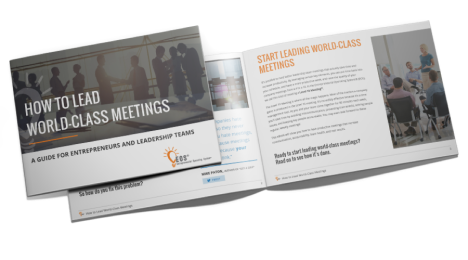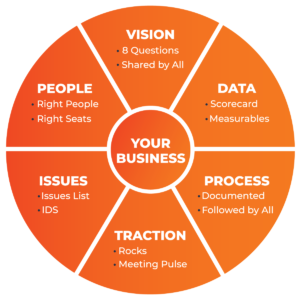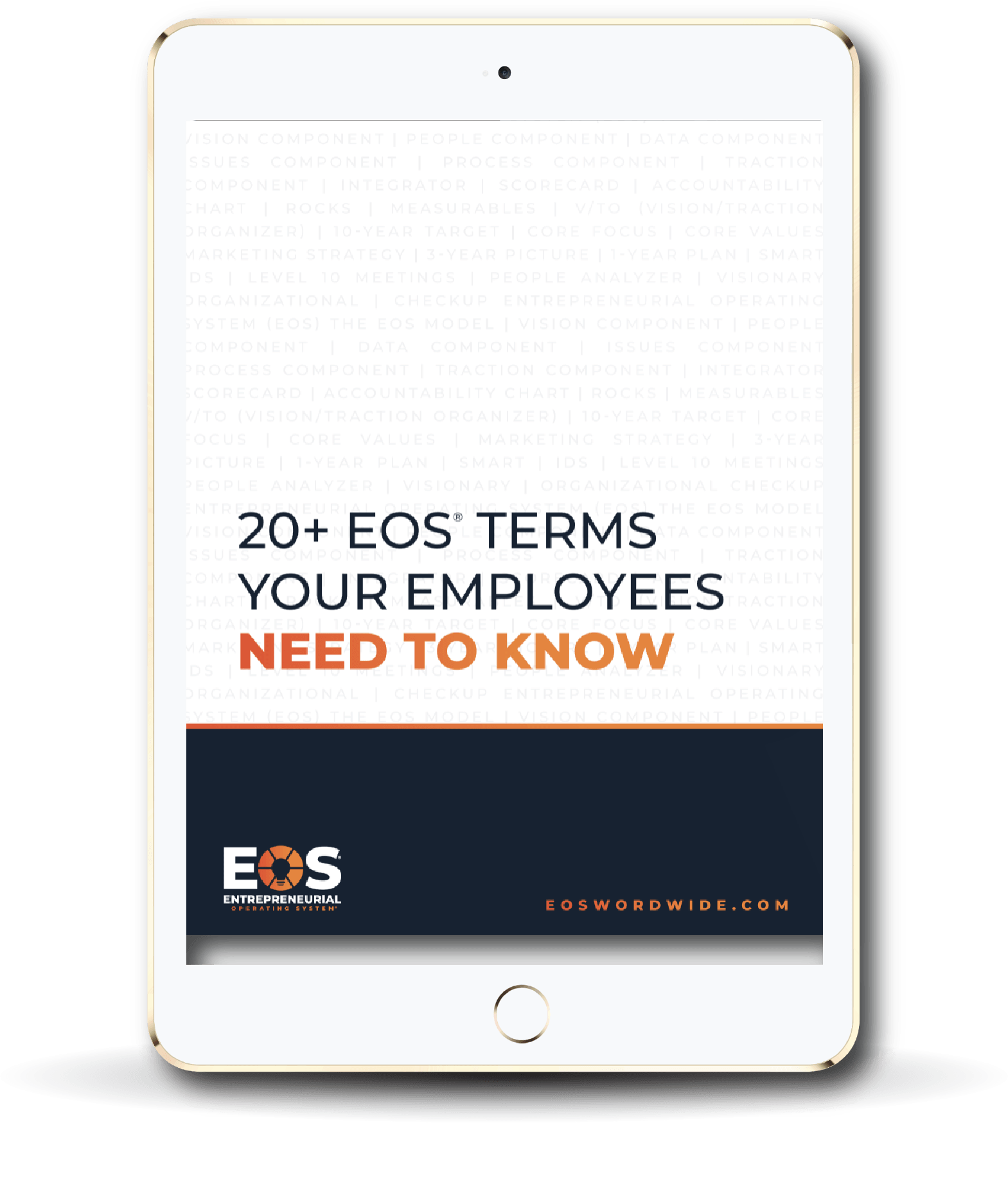Successful business leaders are incredibly passionate about what they do, but they don’t lead with emotion. You have to be able to formulate plans, collect data, and assess the meaning of that data without assumptions, subjective opinions, emotions, or ego. Only factual information can provide the basis for productive discussion and decision-making.
EOS® and Small Business Growth: A Complete Guide to Success
How do some business leaders make it look so easy?
One day they are working out of a garage and the next, they’re on the Fortune 500 list. Why can’t your business enjoy the same success?
It can. EOS is here to help.
The Entrepreneurial Operating System® was built to help you eliminate all of your business-related frustrations. You’ll learn simple concepts and access useful tools all while consulting with business leaders whose main mission is your success!
Every business struggles to grow and the burden on your shoulders can feel unbearable. You are not alone.
But as the saying goes… “How do you eat an elephant?” One bite at a time! EOS is a resource that will help you approach your struggles differently. With this proven mindset, you’ll take on the challenge of business growth — that overwhelming elephant — and break down the path to success into simple, achievable goals.
What you'll Learn
- Why small business growth matters
- Statistics behind small businesses (and wisdom from those who have been there)
- Four fundamentals for every business leader
- The 5 Stages of Small Business Growth
- How 6 key components can spark new growth
- How to measure your growth
- How to hire the right business consultant
- Potholes to avoid on the road to success
Who this Guide is For
- Hardworking entrepreneurs just starting their dream business
- Business owners troubled by uncertainty
- Leaders who have had success but struggle to maintain it
- Leaders of a business that has hit the ceiling
- Innovators with a thirst for greater challenges and more excitement
Click on any chapter to scroll directly to it
TABLE OF CONTENTS
Chapter 1
What Does It Take To Grow A Business?
Business (noun): the activity of buying and selling goods and services
Growth (noun): the process of developing or of increasing in size
At its most basic, this is why you’re here. You have a business and you want to grow it. But dictionary definitions don’t tell you how to grow a business. If they did, every business would succeed.
20% of businesses fail after one year. 50% of all businesses fail after five years.
There’s a secret sauce between reading the definitions of business and growth and actually growing a business.
There’s plenty of paths to get there, but for the busiest of leaders and the most driven of entrepreneurs, there’s one path that helps your business become what it was always meant to be — without wasting time and resources.
That path is The Entrepreneurial Operating System (EOS).
Chapter 2
Grow Big or Go Home – Why Business Growth Matters
Eventually every great business — and every business with the potential for greatness — will face competition. With a scarcity of resources, staff, customers, and time, the business that doesn’t grow will eventually decline.
That’s not you. You put your blood, sweat, and tears into your business so that your dream would be fulfilled, not so you could watch others overtake you and claim your victories as theirs.
Business growth leads to innovation, new opportunities, new markets, broader clientele, a greater reputation, and new potential. Continuous growth is the only mechanism your business has to reach its maximum success.
That’s why you’re here. That’s what EOS can do for you.

Chapter 3
Statistics Behind Small Business Success
Your Uphill Climb
The top three challenges for small business owners are
- Lack of Capital / Cash Flow
- Recruiting / Retention of Employees
- Marketing / Advertising
80% of small businesses survive their first year while only three in 10 companies celebrate 10 years. [Why do businesses fail? Check out Chapter 10 for more.]
Diversity Matters… Now, More than Ever
25% of small businesses in 2019 are woman-owned.
Women-owned businesses employ more than 9.2 million people across the U.S.
Female entrepreneurship grew by 114% between 1997 and 2017.
Women own than 11.6 million firms in the U.S. and generate, as of 2017, $1.7 trillion.
According to a 20-year study, from 1996 to 2016, minority ownership of small businesses has increased:

Black

Latino

Asian

Other
Small Business Growth is America’s Backbone
Nearly 58 million Americans are employed by small businesses, nearly half of the nation’s entire workforce.
There are 30.2 million small businesses — companies with 500 or fewer employees — in the U.S., making up 99.9% of all US businesses.
44% of the US economy consists of small businesses.
Small businesses drive innovation. They produce 16 times more patents per employee than large companies.
90% of American businesses are family-owned.
Chapter 4
Four Fundamentals Every Small Business Needs
1. Building a True Leadership Team
When you start a business, it’s easy to “go it alone”. But with every step forward the burden becomes greater and eventually you need to rely on others. By bringing in a leadership team that can help define the company’s vision with you, you are prioritizing long-term success with individuals you trust and who share your passion.
2. Hitting the Ceiling is Inevitable, But You Can Breakthrough
Most successful business leaders point to success not as a smooth upward trajectory, but as a handful of moments fighting to break through to the next level of success. These ceilings are real for every business and you will hit a ceiling. What’s important is what you do next.
Your success, like leaders before you, depends on what you do when you hit the ceiling. Do you let it stop you? Do you gather your troops and push forward? You can survive hitting the ceiling by first understanding that the ceilings will be there to test you and second by developing the ability to simplify, delegate, and elevate.
3. You Can Only Run Your Business on One Operating System
You must have one abiding vision, one voice, one culture, and one operating system. Any instance where your company can be pulled in two competing directions means you aren’t moving as one focused unit — and failure is sure to follow! EOS is an operating system that puts everyone on the same page.
4. You Must Be Open-Minded, Growth-Oriented, and Vulnerable
Close-minded individuals rarely get far in business because running a company requires looking to the future with innovative ideas and the ability to predict what’s beyond the horizon — both the good and the bad. Be willing to acknowledge your own weaknesses. Admit where you are wrong. Ask for help when it is needed — nobody succeeds in a vacuum. This can be difficult because so much about being an entrepreneur flies in the face of being vulnerable.
By opening yourself up and asking for assistance, you’ll find you can go farther than ever before. EOS is one tool available to you — if you have the strength to say “I can’t go it alone. What are the resources out there to help get my company to its fullest potential?”
Chapter 5
The 5 Stages of Small Business Growth
While every business owner’s journey is unique (that’s what makes your story interesting!) there are typically five stages of business growth that entrepreneurs experience on their way to success.
When you’re trying to break out of a glass ceiling of sales, [if] you’ve been doing the same thing, at the same level for three, four, five years, you’ve got to start thinking differently and that means you got to act differently.
Stage 1: Existence
Congratulations! You exist. Your business is real and that sets you apart from the thousands of dreamers who never take that step of making their business a reality. You have a long way to go to hit your goals, but you’re already in rarefied air.
You are:
- Small, often a business of one, two, or just a few
- Struggling to get noticed — finding a customer, any customer, feels like your top priority
- Fighting for every inch. Production, processes, and promotion may all be at the bare minimum
- Where many of today’s global giants were when they started out
Ask Yourself: Is my business needed?
You can determine your product-market fit with a few key indicators:
- Identify who you are selling to and what problem(s) your product or service solves.
- Do your research every day. Survey data, product focus groups, complaints or concerns your sales team (early on this could just be you, your mom, and your dog) hears about.
- Start with a narrow focus and hone deep expertise – diversifying too soon or trying to be everything for everyone is a fast path to failure.
- Be specific about what you offer and learn where you can outperform the competition. A better price, a faster service, an innovative new sales technique, or focusing on a specific subset of the market.
- Track your performance. Watch for moments of growth, pain points, and new opportunities.
- Never assume you’ve settled into a perfect process. Customer needs change. Your company’s capabilities will change. Regularly reevaluate where you are and where you want to be.
Stage 2: Survival
Whether you’re in business for a day, a year, or a decade, at some point you’ll hit the ceiling where simply surviving is what matters most. Businesses that reach the survival stage are typically still small, tightly run organizations with minimal business systems. However, they have found a customer base that is willing to pay for their products or services and are able to satisfy them sufficiently for repeat business.
You are:
- Small, with a few dedicated team members – the passionate few who believe in you and your product or service
- Serving a base of customers who were willing to take a chance on what you are selling and have come back more than once
- Dreaming of getting your business out of your garage or beyond the single-page website or Facebook business page you built when you first started
Ask Yourself: How do I keep from closing the doors?
Cash is all you think about here. Finding the money to produce your product, to pay your people, to keep the lights on…you might even sacrifice your own well-being in favor of a dream.
Failure finds the businesses that lack regular, reliable cash flow. Doors close when leaders lack a sustainable business model, a short-term plan, and long-term goals.
Stage 3: Success
Plenty of successful business owners have a story behind reaching Stage 3 and it’s a story that lives on when the company’s history is discussed. It’s the turning point when your profitability allows you to open new doors and make good on old promises.
For some, it was the first time they were able to get out of the red… or move out of their garage and into their own building. For others, it was feeling like they had so much business coming in that it was time to hire more help. Or, maybe it was the day they could finally reward the hard-working employees that helped launch the company with pay raises.
You are:
- Paying competitively
- Growing your team
- Moving up in the world
Ask Yourself: Where does the profit go?
You can use your profits in plenty of ways – each one potentially leading to more success. But whatever you choose, it should lead to greater growth potential. Make sure the path you’ve taken to become profitable is sustainable or is one that leads to other profit opportunities. Your business is on very shaky ground and a misstep could send you back to Stage 2 or out of business altogether.
Focus on improving your processes and systems, fixing any weak points in your product (customer surveys and online reviews can help), and rewarding the staff who sacrificed for your dream. The bridge to Stage 4 is turning shaky and unstable ground into solid footing.
Stage 4: Takeoff
Ask any business leader about when they trusted their business would succeed and it often aligns with Stage 4. Here, you aren’t growing by one or two clients, but by dozens or hundreds. Every month you’re hitting goals that, in Stage 2, you would have thought impossible. Now, however, is the stage where strong management is most important. Your business is growing so fast that it is a struggle to keep up.
You’ve gone from driving a car on a deserted back road to navigating an interstate highway at 70 or 80 miles an hour. At this point, a single misstep, poor management decision, or taking your eyes off the goal could be catastrophic.
You are:
- Confident in your own ability
- The maker of a product that is known, respected, reliable, and necessary
- Capitalizing on new markets and an expanded clientele
Ask Yourself: How do I settle into this level of growth?
This is the stage where staffing becomes so essential. Every member of your team is gifted with their own innate talents — those skills and responsibilities they do better than anyone else. As your business grows, you must look to identify those abilities in your staff, and in yourself, and begin to elevate and delegate. The more you can get the right person in the right seat, the more your business will operate like a well-oiled machine.
Consider adding a level of middle management into your team to take some of the daily burdens off your shoulders. Expand the sales and marketing team to keep up with demand. Hire a designer or a public relations expert to create a cohesive message. You’re at a point where what you do has been proven to work — look for new investors who believe in you and whose resources (money, knowledge, etc) can help stabilize your business.
The EOS Accountability Chart™ is a highly regarded resource that clearly outlines the duties of every person on your team – from you to middle management to the daily workforce. It’s a dynamic tool that will grow and change as your business grows and changes. But developing it early is key to ensuring the whole company can row in the same direction.
Stage 5: Resource Maturity
Eventually the growth slows down because no business can sustain exponential expansion forever. Your systems work. Your year-to-year profits are reliable enough that you can plan for future years. Your team grows as much internally as it does from seeking new talent.
Now it’s about settling in to this new world of success.
Rapid expansion doesn’t last forever, and businesses entering Stage 5 face the reality that their growth is slowing. Businesses that reach this stage have well-developed systems and sufficient resources (both financial and human) to start focusing on stabilizing in orbit rather than worrying about reaching it.
You are:
- A trend-setter
- A leader / business that others look to for inspiration
- Successfully driving a business that addresses a problem and offers a solution
- Positioned to consider new products and new opportunities
Questions to ask:
- How do we keep momentum going?
- Where can we grow now?
- Are there new ways for us to innovate?
Reaching stage 5 means provides some relief from the struggles of stage 1 through 3 – but that doesn’t mean you can be complacent. Continue to innovate and stay in tune with changes to your industry and the needs of your customers. Think about what’s next!

Chapter 6
The Six Key Components™ for Conquering Your Growth Dilemma
EOS is about strengthening the Six Key Components of your business and retooling them to move in one single, efficient direction:
Vision
Strengthening this component means getting everyone in the organization 100% on the same page with where you’re going and how you’re going to get there.
People
Simply put, we can’t do it without great people. This means surrounding yourself with great people, top to bottom because you can’t achieve a great vision without a great team.
Data
This means cutting through all the feelings, personalities, opinions, and egos to boil your organization down to a handful of objective numbers that give you an absolute pulse on where things are.
Issues
Strengthening this component means becoming great at solving problems throughout the organization – setting them up, knocking them down, and making them go away forever.
Process
This is the secret ingredient in your organization. This means “systemizing” your business by identifying and documenting the core processes that define the way to run your business. You’ll need to get everyone on the same page with what the essential procedural steps are, and then get everyone to follow them to create consistency and scalability in your organization.
Traction®
This means bringing discipline and accountability into the organization – becoming great at execution – taking the vision down to the ground and making it real.
The result? A healthy, focused leadership team and organization that makes continual progress towards achieving everything in their vision.
Chapter 7
Measuring Small Business Growth
EOS gives you the superpower of objectivity
Through frank discussions and time-saving processes, you and your team can boil down the management of your business to understanding a few specific numbers and the actions you can take to affect those numbers.
Get A Scorecard and Make Data-Driven Decisions
A Scorecard gives you a pulse on your business and helps you strip out the subjective feelings that sometimes drive decision-making in an entrepreneurial company.
Whether it’s a dashboard, flash report, metrics, measurables, key performance indicators, or smart numbers, a Scorecard tells you and your team everything you need to know to plan for the future, based on real data.
A lot of EOS companies struggle at the start of their journey with their Scorecard by trying to monitor too much information instead of focusing only on a handful of measurables. As a result, they don’t love their Scorecard and it doesn’t work well for them. If that is the case for you and your Scorecard, here are 5 steps you can take to troubleshoot your Scorecard issues and make it work better for you.

Chapter 8
Hiring the Right Consultant (and avoiding the wrong ones)
You can’t see the storm when you’re in the eye of the hurricane. Sometimes you are too close to see where you are drifting off-track. That’s why it’s important to reinvigorate your business with fresh eyes from time to time.
A small business consultant will see your issues clearly and objectively and help you solve them for good.
They’ll ask hard questions:
- Are you seeing a dwindling cash flow?
- Does your business lack proven processes, measurable KPIs, or clear accountability?
- Is there weak leadership somewhere in your company’s hierarchy?
- Does your team fail to embrace the vision and goals you’ve put in place?
- Are there points of inefficiency or have you put skilled talent in roles below their capacity?
Any or all of these business constraints can reduce or eliminate your company’s growth potential and, many times, the person at the helm is too personally invested to notice problems when they pop up. Fresh eyes can help an existing business discover success and help a successful business truly takeoff.
You’ll need to factor in your company’s size, location, business stage, specialty, and industry when hiring a business consultant.
Whether you need a problem solver, a fresh perspective, or someone quick to adapt, have a conversation with an EOS Implementer and see if the path they offer is a winning route for your team.
An EOS Implementer has the teaching, facilitation, and coaching skills to help business owners, leaders, and managers get more of what they want from their business.
Chapter 9
Words of Wisdom From Business Leaders Who Have Been There
“If you cannot risk, you cannot grow. If you cannot grow, you cannot become your best. If you cannot become your best, you cannot be happy. If you cannot be happy, what else matters?”
“Becoming isn’t about arriving somewhere or achieving a certain aim. I see it instead as forward motion, a means of evolving, a way to reach continuously toward a better self. The journey doesn’t end.”
“Every problem is a gift — without problems we would not grow.”
“Only those who will risk going too far can possibly find out how far one can go.”
“The journey of a thousand miles begins with a single step.”
“If you really look closely, most overnight successes took a long time.”
“Even if you are on the right track, you’ll get run over if you just sit there.”
“Whatever it is that you think you want to do, and whatever it is that you think stands between you and that, stop making excuses. You can do anything.”
“The road to success is always under construction.”
“Fearlessness is like a muscle. I know from my own life that the more I exercise it the more natural it becomes to not let my fears run me.”
“Find the smartest people you can and surround yourself with them.”
Do not be afraid to make decisions. Do not be afraid to make mistakes.
The price of inaction is far greater than the cost of a mistake.
"Define success in your own terms, achieve it by your own rules, and build a life you’re proud to live.”
Quotes from Gino Wickman, author of “Traction: Get a Grip on Your Business”
“Clarify your vision and you will make better decisions about people, processes, finances, strategies, and customers.”
“Life is much easier for everyone when you have people around you who genuinely get it, want it, and have the capacity to do it.”
“When everything is important, nothing is important.”
“What gets measured gets done.”
Chapter 10
10 Open & Honest Business Questions to ask yourself
Many of the problems you face today are the same ones that have plagued business owners for centuries. The difference between those who failed and those who succeeded wasn’t just about how hard they were willing to work for what they wanted – it was about how honest they were willing to be with themselves.
Start being honest with yourself by asking these ten questions:
- Is there a market need for what you offer?
- Do you have the cash / resources to keep the lights on and plan for the future?
- Is your team the right team?
- Is there someone out there doing what you do better than you?
- Are your pricing and costs all wrong?
- Do you ignore obvious needs of the consumer?
- Is your business lacking an effective model for getting the job done?
- Are you failing to market your business in a way that attracts new customers?
- Is your business losing focus or trying to be something it’s not?
- Do you find your team is trying to row in many different directions?
The wrong answer to any of these questions should sound an alarm and push you to fix the problem before the problem gets out of hand. The EOS Process® — and the relevant, regular conversations that are at its core — can help you identify questions like these to ask, truthfully answer the questions, and locate solutions to get back on track.
One more thought – don’t allow your growth to be stalled by fear — fear of conflict, lack of focus, lack of discipline, or an overabundance of ego — confront the issues facing your business with the same grit and determination you used to create your business. You and your team can come together to Identify, Discuss, and Solve — three key points on the EOS Issues Solving Track™ — and develop the strategy to push past previously impenetrable barriers. [Worried about stepping on toes? Don’t be! Ask an EOS Implementer® about the 10 Commandments of Solving Issues.]
EOS Glossary
Terms to Help you Navigate EOS
EOS® is a language onto itself. Here are a few EOS terms from our glossary that will help you navigate the Entrepreneurial Operating System® for the first time – or at least help clarify a term that you’ve heard before but are unclear about:
Entrepreneurial Operating System (EOS): A proven set of simple, practical tools that improves how people in an organization meet, solve problems, plan, prioritize, follow processes, communicate, measure, structure, clarify roles, lead, and manage.
The EOS Model®: Every business is comprised of Six Key Components™ as depicted by the EOS Model. Those six components are: Vision, People, Data, Issues, Process, Traction®. These must be managed and strengthened to create a healthy, well-run business.
Vision Component: Getting everyone in the organization 100% on the same page with where your company is going and how you’re going to get there.
People Component: Getting the right people in the right seats.
Data Component: Using a handful of numbers that give everyone an exact pulse on where things are and when they are off track.
Issues Component: Strengthening your organization’s ability to identify issues, discuss them, solve them, and make them go away forever.
Process Component: “Systemizing” your business by identifying and documenting the core processes that define the way to run your business.
Traction® Component: Bringing discipline and accountability into the organization.
Integrator: The leader of a company’s leadership team. Integrators beat the drum, break the ties, harmoniously integrate other major functions in the organization, and accept ultimate accountability for achieving results.
Scorecard: An EOS Tool used to track a handful of numbers that give you a pulse on your business.
Accountability Chart™: Different from an organizational chart, an Accountability Chart defines the right structure for your company and clearly identifies who is accountable for what.
Rocks: The three to seven most important things you must get done in the next 90 days. Employees will typically have one to three individual Rocks each quarter while leadership team members will typically have three to seven individual Rocks.
Measurables: When companies use EOS, everyone “has a number” that is considered their measurable – something they do to contribute value to the organization that is measured on a consistent basis.
V/TO™ (Vision/Traction Organizer™): A two-page document that helps your leadership team define, document, agree on, and share the company vision.
10-Year Target™: A long-range, energizing goal for the organization, ranging from five years to 20 years out.
Core Focus™: Your core focus defines what you are as a company to help you avoid “shiny stuff” and keep you focused on the areas where your business excels. It comes from the intersection of knowing “Why” your company exists and “What” you do in the world.
Core Values: A timeless set of guiding principles that define your culture and the behaviors you expect from each other. They help you determine who fits your culture and who doesn’t and they help you attract like-minded people to your team.
Marketing Strategy: The definition of your ideal customer and the most appealing message to attract them to your business. It should provide a laser-like focus for your sales and marketing efforts.
3-Year Picture™: A definition of what your company will look like, feel like, and be like in three years. The 3-Year Picture creates a powerful image of the future and helps everyone work towards the same vision.
1-Year Plan: Defines your objectives for the year by identifying and crystallizing your revenue target, profit target, and measurables, along with your top three to seven goals for the year.
SMART: Stands for Specific, Measurable, Attainable, Realistic, and Timely. Making goals and Rocks SMART is essential for creating crystal clear communication and for setting the right expectations between you and your team so everyone knows what “done” looks like.
IDS™: Also known as the Issues Solving Track™, IDS is the process your team uses to identify, discuss, and solve issues on an ongoing basis.
Level 10 Meetings®: A weekly meeting with a specific agenda designed to help you stay focused on what’s important, solve issues effectively, and keep your team connected.
People Analyzer™: A simple tool that pulls your core values and Accountability Chart together to help your organization identify if they have the right people in the right seats.
Visionary: Often the company founder, a visionary is a strategic thinker who always sees the big picture and is tuned into the future of your industry. Visionaries are usually great with big relationships and the culture of the organization.
Organizational Checkup®: A 20-question survey that helps measure a company’s strength in the Six Key Components.







